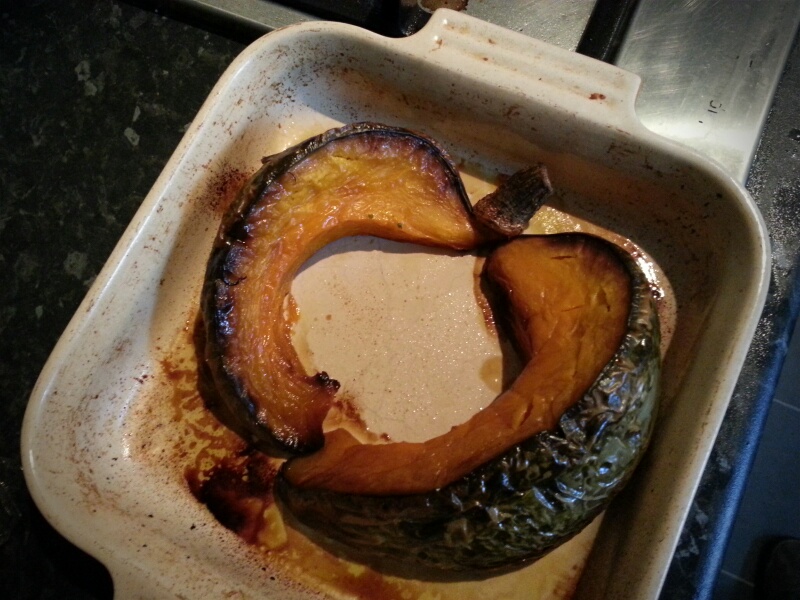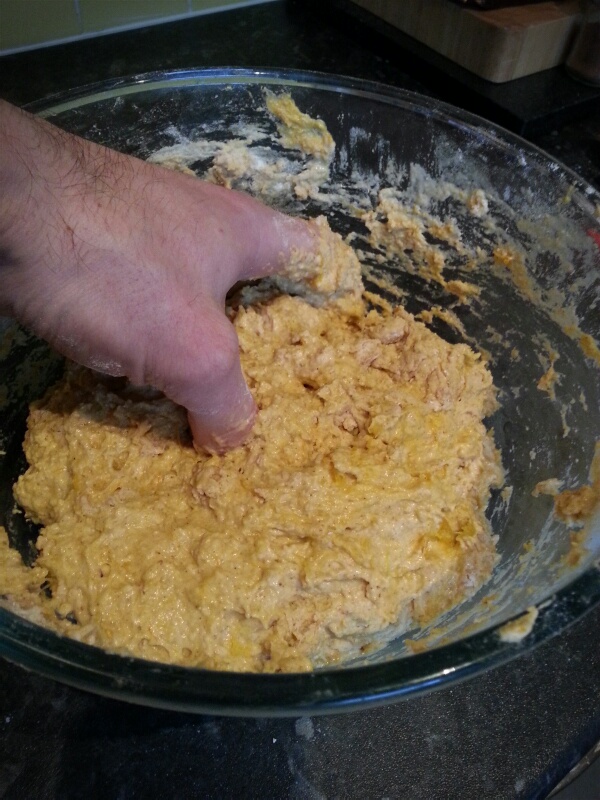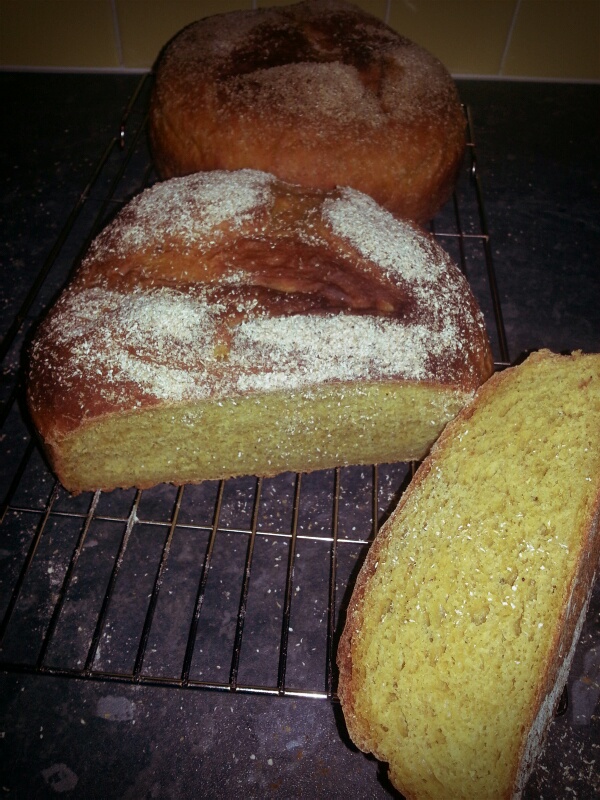I was recently bequeathed a lovely home-grown organic pumpkin from my good friends Simon and Rachel Wallace – they are slowly but surely building up a small-holding on a farm in the Derbyshire country. They are living the dream, and I am more than a little jealous. Anyway, I wanted to do the lovely pumpkin justice and make some nice meals. I remembered a recipe for pumpkin bread that appears in English Bread and Yeast Cookery by Elizabeth David. She takes it straight from the original manuscript, an 18th century periodical called The Family Magazine. Back then pumpkins were more commonly called pompions, and it is more like some advice rather than a recipe:
Slice a pompion, and boil it in fair water, till the water grows clammy, or somewhat thick; then strain it through a fine cloth, or sieve, and with this make your Bread, well kneading the dough; and it will not only increase the quantity of it, but make it keep moist and sweet a month longer than Bread made with fair water only.
The Family Magazine, 1741
It funny that the British have always had a thing for bread that stays ‘fresh’ for as long as possible; the French, for example, expect the opposite and buy there’s once or twice daily . It goes back to the days when the old brick bread ovens were lit but once a week so the bread – and other goodies – had to last. This love for bread with a long shelf-life is also often blamed for our love of the moist mass-produced packaged breads that go mouldy before they go stale, but I digress.
If you like the blogs and podcast I produce, please consider treating me to a virtual coffee or pint, or even a £3 monthly subscription: follow this link for more information.
I thought I would give this pompion bread a go, but I felt that boiling the poor thing to death was a bit wasteful, and I wanted the bread to have some pumpkin flavour so I roasted it, mashed it up and added it to a basic bread dough along with a little sugar and some mixed spice. It turned out to be delicious so I thought I’d give you the recipe to try. I don’t think it resembles the original recipe, but it certainly inspired me to make it. By the way, it doesn’t stay fresh for a month, but it is very much moist and edible five days later. It goes great with soup and stews or with jam or just butter spread on it.
This recipe makes 2 good-sized loaves.
What you need:
600g piece of pumpkin or other squash, deseeded weight
500g (1 lb 2 oz) strong white flour
50g (2 oz) fine oatmeal
1 ½ tsp mixed spice
25g (1 oz) fresh yeast, or 1 tsp dried instant yeast
2 tsp salt
50g (2 oz) sugar
25g (1 oz) softened butter or olive oil
225g (8 oz) warm water
olive oil
extra flour
extra oatmeal
What you do:
Begin by roasting the pumpkin in a little olive oil until soft – around 30 minutes at 180⁰C (350⁰F). When cooked, remove from the oven, cool, remove skin and mash to a pulp.
Mix the flour, oatmeal, mixed spice and sugar in a bowl, then crumble the fresh yeast on one side of the bowl, and spoon the salt one the opposite side. Make a well in the centre and pour in the water along with the olive oil. Notice that I have given the weights of liquids here – I’ve taken to doing this with all my baking recently; you can be much more accurate that way. (For most water-based liquids one millilitre weighs one gram. You can thank Elizabeth David for that one.) Lastly, add the cool pumpkin.
Using you hand, mix everything to a sticky dough – it will be very sticky but don’t worry.
Rub a teaspoon or two of olive oil on your work surface and turn out your dough onto it; the oil makes it easier to knead without it all becoming a hideous sticky mess. Keep kneading and adding more oil if need be. If all this seems like too much effort and mess, use the dough hook on a food mixer instead.
When the dough is smooth, do a final kneading on a little flour, then pop into a clean bowl that has been lightly coated with oil to prevent sticking. Cover with Clingfilm (other plastic wraps are available) and allow to ferment away until it has at least doubled in size.
Knock back the dough and shape into two loaves – you can do round cobs on a greased baking sheet or in greased tins, whichever you prefer. i used two cake tins so that my cobs would keep some shape.
Cover and allow to prove. Make appropriate cuts and dustings of flour or oatmeal. When doubled in size put into a cold oven. Set the temperature to 220⁰C (425⁰F) and leave for 15 minutes. Turn the heat down to 180⁰C (350⁰F) and bake for a further 15 minutes. Allow to cool on a rack completely before breaking into it.





Love the colour of this bread! It looks fantastic.
LikeLike
Thank you! It’s always good when a made-up recipe comes out well
LikeLike
Brought up this matter of the difference between the value traditionally put on keeping quality with my friendly local traditional French baker (in north County Dublin) and he corrected me – while the baguette is bought fresh once or twice a day a good pain de campagne should in fact keep for a week and country bakers in France often only baked once a week until somewhere around WW2 – they mostly had other jobs the rest of the week and didn’t have enough customers to justify baking as a full time job. He only opens two days a week to the public ( he’s mostly wholesale) and recommends wrapping in foil and freezing his bread, placing it in a very hot oven for 15 minutes to re-bake. But his bread does indeed keep almost fresh for a week. And it is absolutely delicious. So good that I’m baking much less myself 🙂
LikeLike
Cheers for that Kathryn – every day’s a school day and I take it back. I do love a good pain de campagne. Never tried to make one though – have you?
LikeLike
Pingback: From My Kitchen to Yours: Pumpkin Bread, a Delicious Autumn Treat – The Cooper Point Journal
Pingback: Vegan Pumpkin Spice Bread - plant.well